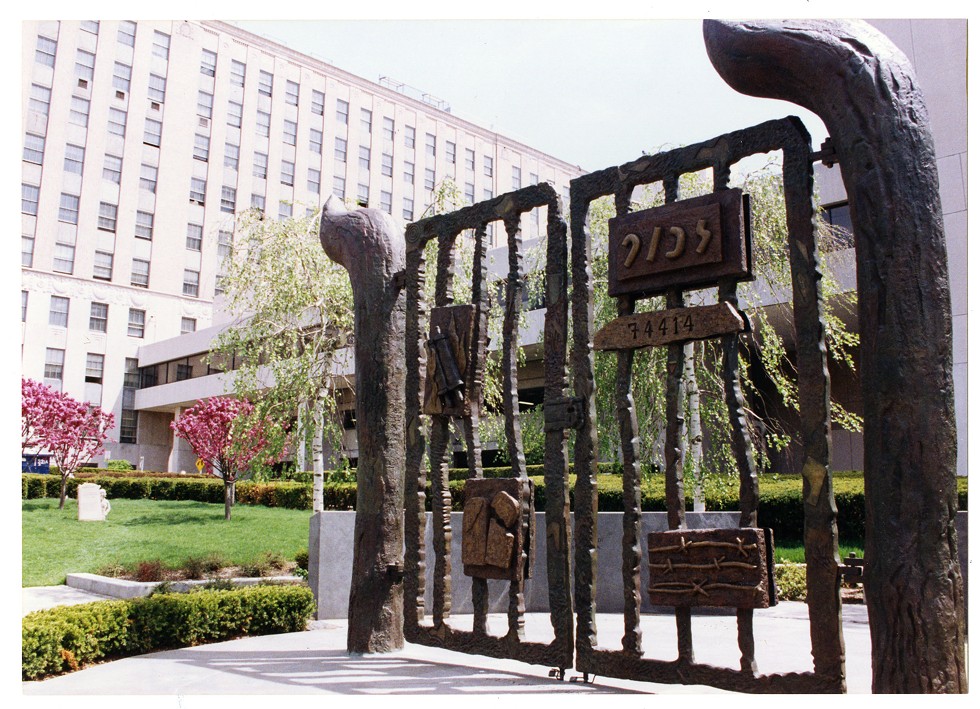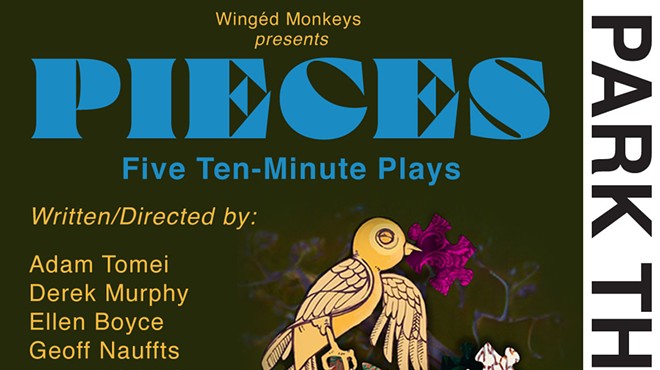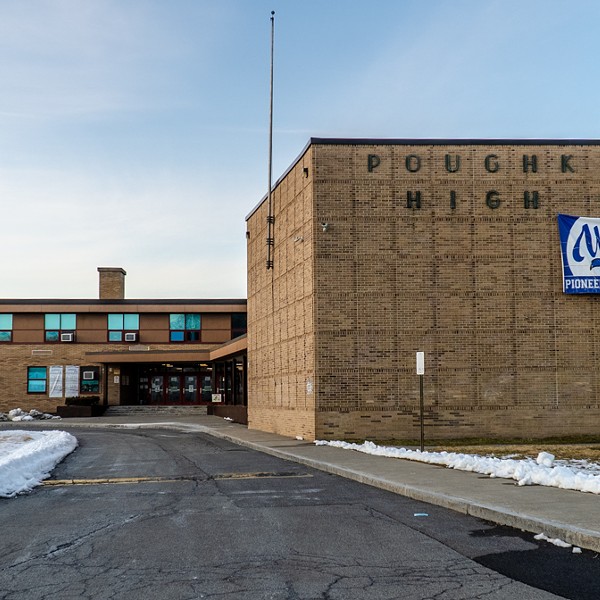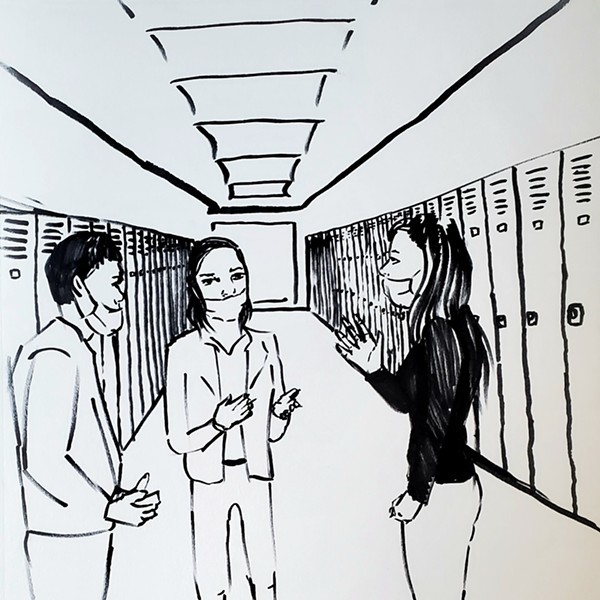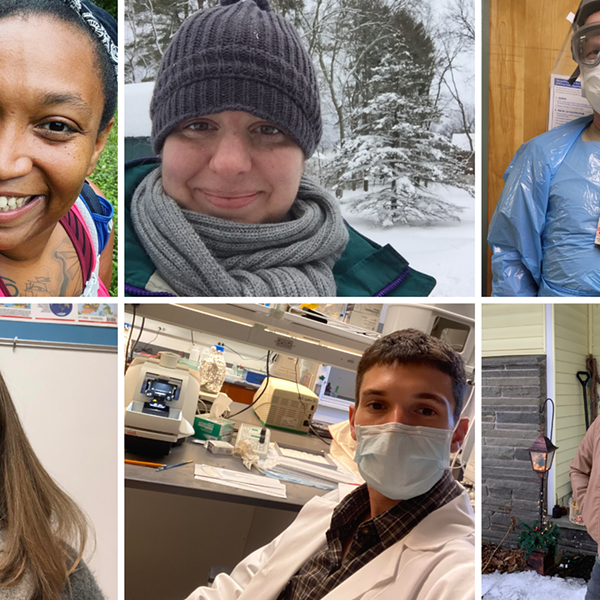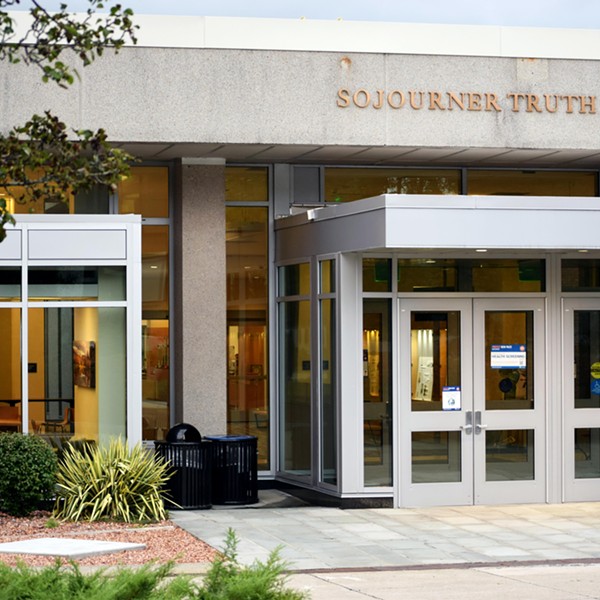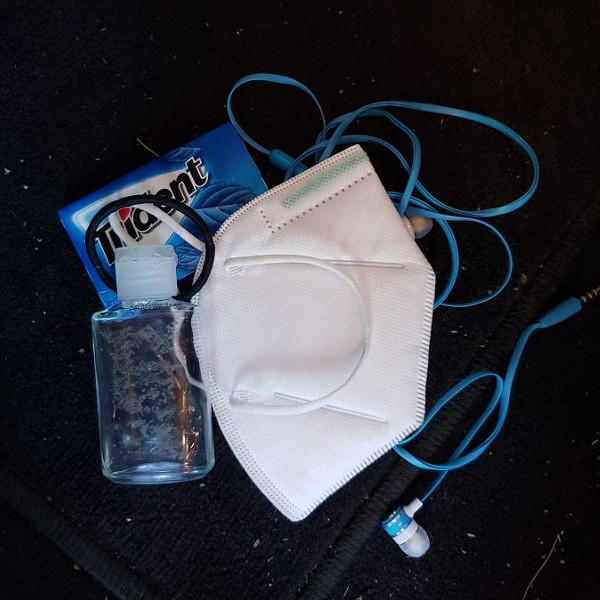In September, the Conference on Jewish Material Claims Against Germany, an organization that negotiates and distributes compensation for Holocaust survivors, published the results of a survey on Holocaust knowledge and awareness of 11,000 United States residents in all 50 states between the ages of 18-39. The survey was the first effort to measure Holocaust education among millennials and Gen Z across the country, and its 36 questions gauged basic awareness (“Have you ever seen or heard the word Holocaust before?”), historical knowledge (“In which country or countries did the Holocaust take place?”), exposure to Holocaust education (“At what level of school did you learn about the Holocaust?”), and personal opinions and values (“Do you think that it is acceptable for an individual to hold neo-Nazi views?”).
The report suggests an alarming trend about America’s historical memory: 63 percent of respondents did not know that 6 million Jews were murdered in a genocide that ended just 76 years ago. New York was listed among the states with the lowest Holocaust knowledge scores, despite the fact that it is one of only a handful of states that mandates Holocaust education in K-12 schools.
However, the Claims Conference report provides only a partial view of Americans’ understanding of and attitudes toward the Holocaust. Following its publication, Eleanor Cummins wrote for Slate about the study’s “methodological choices that conflate specific terms (the ability to ID Auschwitz) and figures (that 6 million Jews were murdered) about the Holocaust with general knowledge of it, and knowledge with attitudes or beliefs toward Jews and Judaism.” These criteria for what constitutes Holocaust knowledge are misleading.
“It’s not simply the numbers,” says Dr. Alan Goldberg, professor emeritus at Syracuse University’s School of Education. Dr. Goldberg says the most critical components of Holocaust education lie beyond the rote memorization of statistics or the names of concentration camps. The report’s findings “don’t get at the root issues that we ought to be talking about,” such as respondents’ understanding of dehumanization, fascism, and moral reasoning.
More concerning are the survey’s results for values-based questions, for which New York was consistently an outlier. For example, 19 percent of respondents in New York—more than any other state—believed that Jews caused the Holocaust. Compared to national averages, twice as many New Yorkers believed that the Holocaust did not happen, agreed with the statement “people still talk too much about the Holocaust,” and felt that it is acceptable for a person to hold neo-Nazi views.
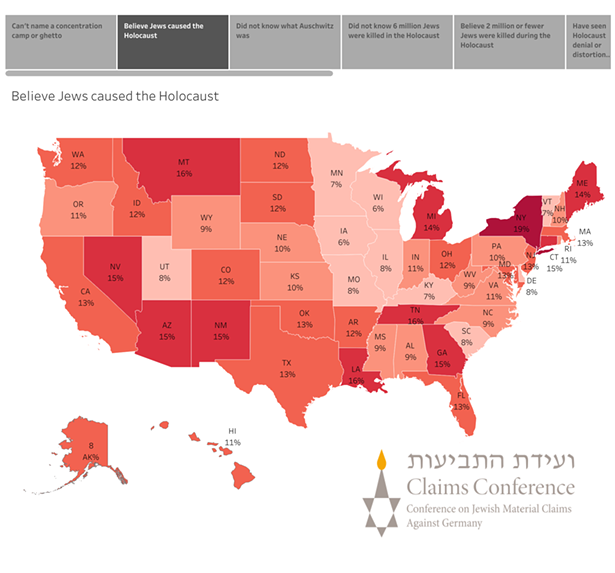
When considering their implications for how New York State approaches Holocaust education, the Claims Conference findings beget more methodological questions. For example, it is unclear how many of the New Yorkers surveyed attended K-12 school in the state. While Helen Turner, director of education at the Holocaust Memorial and Tolerance Center of Nassau County, had many questions of the survey’s methods, she looked for practical implications of the new information. “I think what we’re seeing is, very simply, we need more robust Holocaust education,” she says.
Less emphasized data from the Claims Conference survey showed that only 52 percent of New York respondents—fewer than any other state by several percentage points—first heard of the Holocaust at school. By contrast, the state had the highest rate of respondents who first learned about the Holocaust on social media.
While these numbers need to be taken with a grain of methodological salt, they point to several issues undermining effective Holocaust education throughout the state: the Holocaust education mandate and curriculum guidelines are nonspecific, implementation is inconsistent across teachers and districts, teachers often need more support than they have access to, and limited classroom time inhibits in-depth learning. Meanwhile, students are spending more time online than ever, and the influence of Holocaust denial and distortion and white supremacy is rising in online spaces.
Creating Citizens
Holocaust education is a demonstrably strong predictor of certain citizenship values, such as rejecting racism and prejudice and acknowledging social responsibility. This is particularly salient in light of the recent attack on the US Capitol, which emerged from the mainstream embrace of racist, antisemitic conspiracy theories.
“When we study the history of the Holocaust and other genocides and collective violence, we’re studying what went wrong,” says Laura Tavares, program director for organizational learning and thought leadership at Facing History and Ourselves, an educational organization that develops social studies curricula for teachers. “In that study, we’re gaining some insight into the kind of individual and collective decision-making that is necessary to actually sustain democracy and human rights.”
New York school districts have made headlines with disastrous attempts to teach the Holocaust and other genocides. In 2013, an Albany High School teacher assigned students a persuasive writing exercise in which they were instructed to “argue that Jews are evil, and use solid rationale from government propaganda to convince me [the teacher, posing as a Nazi official] of your loyalty to the Third Reich!” In 2017, students in Oswego County were given a similar assignment to argue either for or against the extermination of the Jews; when students spoke out, the school administration initially refused to apologize or remove the assignment. The students’ advocacy efforts led to the creation of NY Senate Bill S.5530, which would authorize the commissioner of education to conduct a study of schools’ implementation of Holocaust education.
The state of Holocaust education may also indicate if and how other historic human rights issues are being taught in classrooms. Like the classroom simulations of Nazi propaganda, New York schools have also come under fire for recent misguided lessons on American slavery, such as when a Freeport teacher held mock slave auctions or when Port Chester students were instructed to write their own runaway slave advertisements. The New York Times’ 1619 Project has documented the nationwide trend of K-12 lessons on slavery as inaccurate, incomplete, or missing altogether.
These examples of classroom simulations and meager curricula aren’t disturbing because they fail to teach students names and dates, but because they end up reinforcing common misconceptions and point to systemic failures to equip teachers with necessary pedagogical tools.
The History of Holocaust Education in New York
In 1994, New York’s legislature passed a bill amending the New York Consolidated Laws regarding courses of instruction in “patriotism, citizenship, and human rights issues” to specifically mandate teaching the Holocaust. The mandate applies to all students over the age of eight, and made New York the third state, after California and New Jersey, to have such a requirement (there are 15 states with mandates today).
This happened amid what Turner describes as a national “surge” of Holocaust education in the 1990s, when many living survivors were openly telling their stories, and Holocaust museums and memorial centers were opening throughout the United States. “I think now all Holocaust educators are asking ourselves, what do we do after the surge?” she says. “How do we keep this history relevant, how do we keep students engaged?”
Holocaust education is mandated in the law generally, without specifics on implementation, according to Steve Goldberg, the co-director of education at the Holocaust & Human Rights Education Center in Westchester and a recent president of the National Council for the Social Studies. “It’s not stipulating as to when and how, and it’s an unfunded mandate; ergo, who’s going to pay for curriculum and materials?”
In 2014, the state education department made the first major overhaul of New York’s social studies curriculum in 15 years by releasing the K-12 Social Studies Framework, which was “designed to prepare students for college, careers, and civic life” by combining Learning Standards and Common Core Standards for Literacy and Writing into one document. (It was later updated in 2016.) Rather than focusing on disseminating information, the new framework puts greater emphasis on understanding concepts, analytical skills, and engagement with materials and context. It outlines social studies practices such as interpreting evidence, arguments, and bias, or striving for extensions of freedom, social justice, and human rights, which include those “root issues” referenced by Dr. Alan Goldberg.
Across the US, “state laws [mandating Holocaust education] vary widely—some provide funds or suggest curricula, others do not,” Elaine Povich wrote for Stateline, an initiative of the Pew Charitable Trusts, in 2019. “Some specify when or how the lessons should be incorporated into courses, while others are less prescriptive.” Compared to states like California, whose education department issued a model curriculum for human rights and genocide in 2000, New York is relatively hands-off in its approach. While the state sets the learning standards, according to New York State Education Department (NYSED) officials, “it is the responsibility of each local school district to develop curricula based on these NYS Learning Standards, select textbooks and instructional materials, develop pacing charts for learning (scope and sequence), and provide professional development for staff to ensure that all students have access to instruction leading to attainment of these learning standards.”
Comprehensive and consistent teacher preparation and professional development may be one of the greatest challenges to effective Holocaust education. According to NYSED, prospective social studies teachers must complete a registered teacher preparation program, receive an institutional recommendation, complete a workshop on New York’s anti-bullying law, and pass several exams, including the Content Specialty Test, “which covers all specific content a social studies teacher may cover, including the Holocaust.” But these exams are broad and fail to assess new teachers’ exposure to specific pedagogical tools and methods for teaching about genocide and human rights violations, including the Holocaust.
Stephanie Catania is a social studies teacher at Somers High School in Westchester and a recipient of the Susan J. Goldberg Memorial Teacher Award for her teaching of the Holocaust. In her experience, limited classroom time and demanding requirements may prevent teachers from covering the subject thoroughly. “We assume that kids know it,” she says, referencing how some teachers may think that high school students are already familiar with the Holocaust since it is covered in the 8th grade curriculum. “I don’t think that all teachers are doing this, I just think we sometimes get caught up in, ‘We have to meet these standards, and we have to get to the Regents.’”
Teacher preparation programs vary widely, and cover a wide-ranging, demanding amount of content in just a few years. A 2006 study by the United States Holocaust Memorial Museum showed that most teachers cited their own high school coursework as the primary source of their Holocaust-related content knowledge, and a 2019 study of preservice social studies teachers in New Jersey (whose mandate includes a Holocaust curriculum) found that much of that high school coursework was limited to a screening of Schindler’s List and a few sentences in a textbook. Catania intentionally sought more education, such a Spector/Warren Fellowship with the Holocaust Museum Houston and a seminar at Yad Vashem, but these experiences are unrepresentative of many K-12 teachers.
Although institutes like the Holocaust & Human Rights Education Center and the Museum of Jewish Heritage offer state-approved training for K-12 teachers, getting the word out to schools is a challenge. For Turner, one of the most difficult networks to access is superintendents. When she recently presented at a conference for principals in Nassau and Suffolk counties, she noted that “one of the big things that came out of the conference was, how do we stay in touch?” underscoring the lack of an accessible communication network between districts and resources. “I would love to see something a bit more centralized and organized in the Department of Education. I think that would help all cultural institutions.”
The NYSED website has a page of links related to teaching social studies, including a link to Learning For Justice (formerly Teaching Tolerance), an education project of the Southern Poverty Law Center that offers age-appropriate learning plans about the Holocaust. The department also created the annual Yavner Award, which recognizes an educator for outstanding teaching of the Holocaust. Nationally, there are well-developed online resources available for educators, such as Echoes and Reflections. Of course, the internet is also full of well-meaning misinformation and intentionally misleading disinformation, and with minimal guidance from New York, the role of dissemination and recommendation of resources is left up to individual districts. This contrasts with states like Texas and Connecticut, whose education departments maintain websites solely focused on Holocaust and genocide education.
The result is that teachers in regions without a dedicated museum or center may not receive the same outreach about updated and innovative resources for Holocaust pedagogy that their peers in better-resourced areas do. Twenty-two of the 28 Holocaust organizations in New York State are located in the New York City metropolitan area, and the only two that are approved Continuing Teacher and Leader Education Sponsors are in Manhattan and Westchester.
How to Address the Problem
Teaching about genocides and other mass atrocities requires skill, knowledge, and a measured approach. “Young people absolutely are capable of deliberating on the big moral issue that this history raises, but it has to be done with a degree of nuance and sensitivity that really requires some training,” says Tavares. She says that failed classroom simulations often begin with teachers’ positive intentions to help students understand the gravity of the history and engage in moral reflection. “But when teachers don’t have sound pedagogical tools and they resort to activities like that, it can really do more harm than good and it can even be traumatizing.” Tavares notes that much of Holocaust education isn’t happening in social studies classrooms; instead many students are learning about the Holocaust through English reading assignments, including works of fiction, which only offer a glimpse of historical context.
One common conceptual error in Holocaust education is that it is often taught separately from other mass atrocities, which can inadvertently convey the idea that the Holocaust is an unreproducible or incomparable event (it’s worth noting that the term genocide was coined partially in response to the Armenian Genocide, which may get even less airtime in New York classrooms). There are also contemporary and ongoing campaigns of genocide (such as those against the Uyghur and Rohingya ethnic groups), and a renewed focus on understanding how the American history of genocide against African and Indigenous peoples continues to play out today. Teachers may often encounter pushback from students; Turner, who conducts workshops at the Holocaust Memorial and Tolerance Center, has experienced this “especially from students who feel their own history has been silenced or reduced.”
Experts in Holocaust education recommend best practices such as avoiding comparisons of pain and addressing systemic racism, antisemitism, and all other forms of persecution. Turner’s response to student resistance is to “look at why that’s happening, because we know that some peoples’ histories are not centered, are not valued in the same way…and help them approach the school or the curriculum or Albany with how to make the big systemic changes.” Educators such as Bettina Pope aim to equip students to be antiracist change agents through the teaching of the Holocaust. The US Holocaust Memorial Museum is currently offering a virtual exhibit on Black voices from the Nazi era, which examines how the events of World War II illuminated systemic racism in the United States. Many Holocaust centers, including the Holocaust and Human Rights Education Center in Westchester, have outreach programs that focus on symbols of hate and restorative justice.
Time is an invaluable resource for schools looking to encourage teacher development and enhance students’ learning. “When there’s time in the curriculum to slow down and privilege depth over breadth, I think those are the schools that are more likely to be successful,” says Tavares. Schools may also need to set aside time for professional development and make substitute teachers available so that teachers have time to reflect and plan.
Models for policy improvement exist. For example, the Texas Holocaust and Genocide Commission, created by an act of Texas Legislature in 2009, has served as an accessible locus for teachers’ classroom resources, professional development, and best practices. In 2019, Texas legislators passed another bill requiring the inclusion of the Holocaust in the Texas public school curriculum and specifically designating the week of January 27 as Holocaust Remembrance Week in Texas schools. The website contains a wealth of information, from recommended lesson plans to age-appropriate reading materials to “red flag terms” that should be used carefully.
While New York’s bill to study schools’ compliance with the mandate passed the Senate, it never progressed further, and has stalled in committees along with its Assembly version for the past three sessions. Even so, the legislation only authorizes the education commissioner to study school compliance, and given the broad nature of the mandate, compliance may not be the issue. For example, a school could be in line with the letter of the law, but may still encounter significant challenges with teacher preparation and resourcing, or may disseminate information about dates, places, and people without engaging students in meaningful discussion about the significance of those facts.
Large-scale change may need to come from out of state. Last year, the US Congress signed Representative Carolyn Maloney’s (D-NY-12) Never Again Education Act into law, which will provide $10 million in funding to the US Holocaust Memorial Museum over five years to expand educational programming, create a centralized website for teaching resources, and expand professional development for teachers.
Holocaust education is about preserving the memory of the 6 million Jews and 5 million others who died in the Nazi genocide, but it is as much about today’s students becoming ethical decision-makers who can practice empathy, prioritize the common good, and act bravely when encountering oppressive actions and language.
For Tavares, funding and resourcing have a strong effect—when partnered with strong communication from educational leadership. Rather than seeing Holocaust education as a brief unit in the study of American or global history, she hopes that administrators, lawmakers, and teachers come to understand it as the heart of “the purpose of education itself.”







